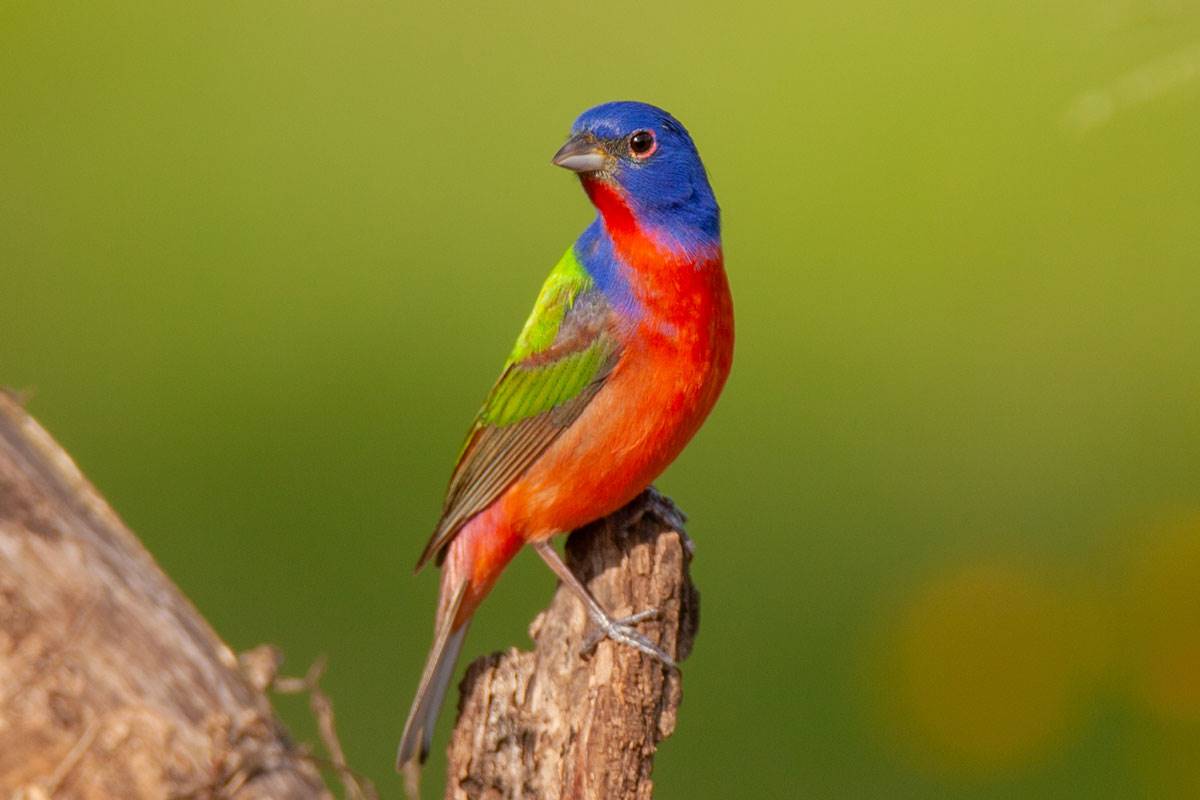

Nothing is more exciting to the average birder than spring and fall migration season. During these months, we get the opportunity to see bird species that may not spend all year in the United States. For birdwatchers in the southeastern U.S., a coveted species is the Painted Bunting. In this article we look at some interesting facts about Painted Buntings to help you learn a little more about their behaviors and habits.

Painted Buntings are sexually dimorphic, meaning males and females have different plumage.
Male Painted Buntings will typically have a blue head with red eye-ring, red from throat to belly, and greenish-yellow upper back. They look like a vibrant watercolor painting. Meanwhile adolescent birds and females are a uniform greenish-yellow which can range from somewhat dull to rather bright. Females and young Painted Buntings can also be distinguished by the pale circle around their eyes.

The male Painted Bunting has long been considered one of . In Mexico, the Painted Bunting is known as , or “seven colors.” In Louisiana they have earned the name , which is French for “without equal”.
In spring and summer, Painted Buntings travel to their breeding grounds which are in two main locations. The western population can be found in the mid-south, including northern Mexico, Texas, Oklahoma, Arkansas, Louisiana and western Mississippi. The second breeding area, or eastern population, is along the southeastern coastal regions of northern Florida, Georgia, and the Carolina’s.

When it gets cool, Painted Buntings head south. They spend the winter in the southern tip of Florida, the Caribbean, Cuba, southern Mexico and Central America.
Painted Buntings prefer scrub-marsh habitats. These habitats are what many might consider looking “unkempt” or “unruly.” In other words, they prefer wild spaces. It’s easiest to find them in areas with trees, scattered shrubs, and weed patches. This semi-open habitat allows the bird to have plenty of space to fly with their group while also keeping shelter from predators during mating season.
However, Painted Buntings that are located on the coast don’t have easy access to this type of habitat. As a result, they’ve adapted to using habitats and terrain that feature singular elements of scrublands. This might include wooded dunes, fallow farmland, or backyards with a lot of shrubs.

The western population of Painted Buntings starts to molt in the early fall right before heading south. The birds then fly into northern Mexico and stop to rest. They will finish their molt here before heading further south.
Interestingly, the eastern population completes their molt before they head south.
Trapping, caging and selling painted buntings for their beautiful colors is a practice that goes back a long way. Audubon himself in 1841 wrote that thousands of painted buntings were caught every spring then shipped out of New Orleans over to Europe. This practice is illegal today but unfortunately still continues, especially in Mexico and Central America.

This fate is similar to another very colorful songbird, the .
While not as common of backyard visitors as some other songbird species, these buntings do visit bird feeders and enjoy sunflower and seed blends. As we mentioned before, they prefer to stay somewhat hidden in shrubby habitat, so having dense shrubs in your yard will make them more likely to visit.

Painted Buntings are granivores for most of the year, eating mainly seeds and grain. However, mating season changes their diet up and they switch over to eating a lot of insects such as grasshoppers, beetles, caterpillars, flies and weevils.
During the winter months, Painted Buntings may hang out together in small flocks. They can be found foraging together with other painted buntings as well as other seed-eating bird species. However being a friendly neighbor changes drastically during the breeding season, which brings us to fact #11.

When the breeding season starts, males vigorously defend their territory, which tends to be about 3 acres in size. They will fight other males pretty ferociously, which can result in lost feathers, wounds and sometimes even death.
When courtship begins, the males definitely try to get on the females good side and impress them. They often fan out and display their feathers to the female. This species is mostly monogamous during the breeding season, which generally lasts between April and August.

While both males and females will work together to find a good nesting spot, it is the females that build the nest.
3-4 eggs are laid and incubated for about 10-12 days before hatching. The female takes care of the babies on her own, and they will remain in the nest for 12-14 days before leaving. About 30 days after her eggs hatch, she will lay a second brood.

The song of the Painted Bunting is a short, high-pitched musical phrase. In the spring when establishing territory, males will fly between several perches and sing 9-10 songs per minute. Neighboring males often “countersing”, or sing back and forth at each other.